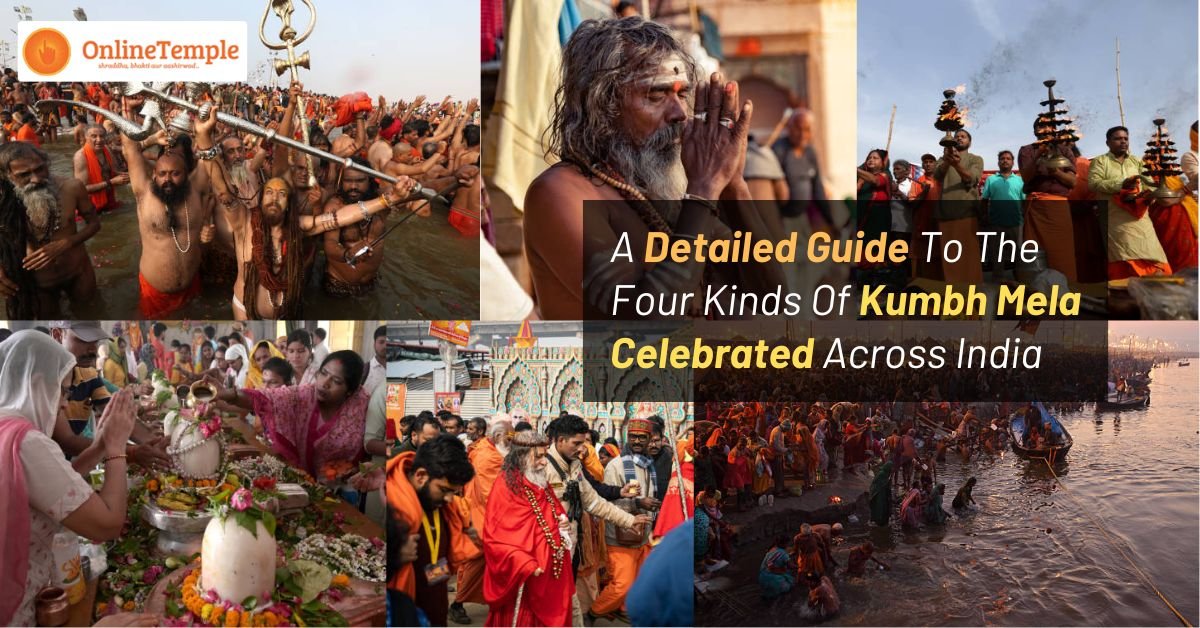Online Temple is here to tell you all about the 4 different kinds of Kumbh Mela occurring in India. Considering the millions of people attending the event every time it occurs; it comes as no surprise that it is the largest festival in the world. It is not just any other festival. It is a ritual that promises spiritual upliftment and renewal. This is the right time to pray Lord Shiva Hindu God with faith. So, come join us as we show you the details of this humongous Indian festival where millions of devotees gather.
Exploring The Differences Between The Four Types Of Kumbh Mela And Where They Are Held
As visible from the title itself, Kumbh Mela is of 4 types. They are held at 4 sacred Indian cities, for starters. These are Prayagraj, Ujjain, Nasik and Haridwar. Technically speaking, Kumbh is a sacred gathering of pilgrims, mostly Hindus. They come and take a ritual bath, called Shahi Snan.
Significance of Kumbh Mela and its story behind the festival
Hindu mythological scriptures tell us that the locations of Kumbh were chosen based on where the Holy Nectar fell. When the churning of the ocean (Samudra Manthan) was taking place, 4 drops of Amrit fell on these locations. This is why they are considered holy and sacred. Pilgrims who visit the Kumbh Mela often take some soil of the place it is being held on.
Kumbh Mela and Its Astrological Significance
The timing of each Kumbh Mela is guided by precise astrological configurations.
- Haridwar: This event happens when Jupiter aligns with Aquarius. At that time, the Sun enters Aries as well.
- Prayagraj: Mela happens when Jupiter is positioned in Aries or Taurus. Meanwhile, the Sun and Moon align in Capricorn.
- Ujjain: Takes place when Jupiter is in Leo and the Sun is in Aries.
- Nashik: Held during the conjunction of Jupiter and the Sun in Leo.
4 types of Kumbh Mela and their locations
This sacred gathering occurs in different forms. And each of them is defined by their timing, location, and astrological significance. So, don’t get stuck on booking puja for education now.
Kumbh Mela is held every 12 years. This grand pilgrimage rotates between 4 holy sites, with each of them located on a holy river.
- Prayagraj: At the confluence of the 3 rivers. Also called Triveni Sangam.
- Haridwar: On the holy Ganga River.
- Ujjain: Along the Shipra River.
- Nashik: Beside the Godavari River.
Ardh Kumbh Mela
Meaning ‘Half Kumbh Mela,’ this event happens every 6 years. It serves as a spiritual midpoint between full Kumbh cycles. It is exclusively hosted at
- Prayagraj
- Haridwar
Purna Kumbh Mela
Also known as the ‘Full Kumbh Mela,’ this grand event follows a 12 year cycle. This Kumbh is determined by the same planetary patterns at their respective locations.
Maha Kumbh Mela
The most significant of all, the Maha Kumbh Mela occurs every 144 years. That means, it happens after 12 Purna Kumbh cycles. This unparalleled event is hosted only at Prayagraj. The event draws millions of devotees who want spiritual purification and enlightenment. That makes it the largest human congregation on Earth.
Conclusion
So, when are you visiting the Kumbh? Will it be this year? Or do you choose among the Ardh and Purna Kumbh Melas. Make your decision after you buy Meru Shree yantra set online with us! This will ensure health, wealth, harmony and prosperity in your family. Before you even visit the festival! What are you waiting for?
Also Read: Navigating Your Way To Kumbh Mela 2025: Routes, Transport, And Travel Tips

